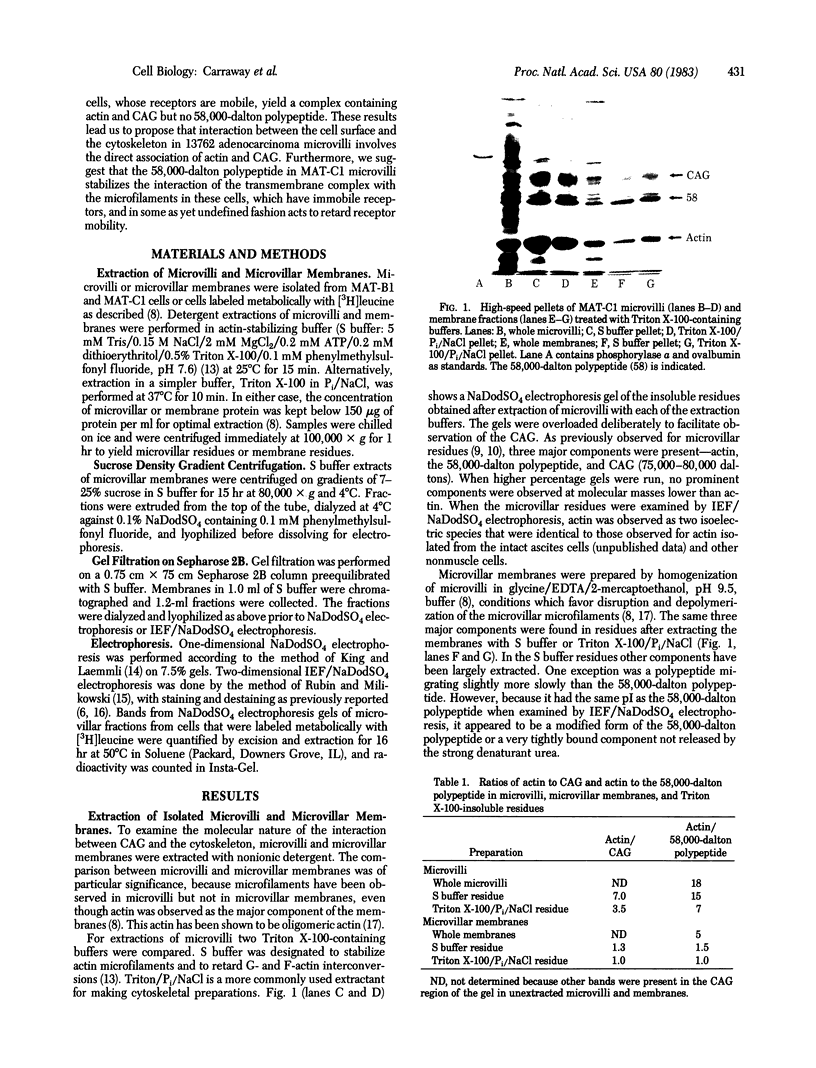Abstract
The molecular nature of the cell surface-cytoskeleton interaction in microvilli isolated from ascites 13762 rat mammary adenocarcinoma sublines with immobile (MAT-C1) and mobile (MAT-B1) receptors was investigated by extraction and fractionation studies on the microvillar membranes. Extraction of membranes from MAT-C1 cells with Triton X-100-containing buffers gave insoluble residues showing three major components by NaDodSO4/polyacrylamide gel electrophoresis: actin, a 58,000-dalton polypeptide, and a cell surface glycoprotein of 75,000-80,000 daltons. The ratio of these components in Triton X-100-insoluble residues, as determined by scintillation counting of bands from gels of [3H]leucine-labeled microvillar membranes, approached equimolar, suggesting a specific complex of the components. The three components of the putative complex cosedimented on sucrose density gradients of Triton X-100/buffer-treated membranes. Gel filtration on Sepharose 2B gave a peak included in the column that contained only the glycoprotein, actin, and 58,000-dalton polypeptide by one-dimensional NaDodSO4 electrophoresis and by two-dimensional isoelectric focusing/NaDodSO4 electrophoresis. The glycoprotein-actin association could be disrupted only under strongly denaturing conditions. Complex prepared from MAT-B1 microvillar membranes by Sepharose 2B gel filtration in Triton X-100-containing buffers contained actin and the glycoprotein but no 58,000-dalton polypeptide. From these results we propose that the cell surface-cytoskeleton interactions in the 13762 tumor cell microvilli involve direct association of actin with the cell surface glycoprotein. We further suggest that the 58,000-dalton polypeptide stabilizes the association of this complex with the microfilaments in the MAT-C1 microvilli, thereby stabilizing the microvilli and restricting cell surface receptor mobility.
Keywords: isolated microvilli, microvillar membranes
Full text
PDF




Images in this article
Selected References
These references are in PubMed. This may not be the complete list of references from this article.
- Bourguignon L. Y., Singer S. J. Transmembrane interactions and the mechanism of capping of surface receptors by their specific ligands. Proc Natl Acad Sci U S A. 1977 Nov;74(11):5031–5035. doi: 10.1073/pnas.74.11.5031. [DOI] [PMC free article] [PubMed] [Google Scholar]
- Branton D., Cohen C. M., Tyler J. Interaction of cytoskeletal proteins on the human erythrocyte membrane. Cell. 1981 Apr;24(1):24–32. doi: 10.1016/0092-8674(81)90497-9. [DOI] [PubMed] [Google Scholar]
- Carraway C. A., Cerra R. F., Bell P. B., Carraway K. L. Identification of a protein associated with both membrane and cytoskeleton fractions from branched but not unbranched microvilli of 13762 rat mammary adenocarcinoma ascites tumor sublines. Biochim Biophys Acta. 1982 Oct 28;719(1):126–139. doi: 10.1016/0304-4165(82)90316-6. [DOI] [PubMed] [Google Scholar]
- Carraway K. L., Cerra R. F., Jung G., Carraway C. A. Membrane-associated actin from the microvillar membranes of ascites tumor cells. J Cell Biol. 1982 Sep;94(3):624–630. doi: 10.1083/jcb.94.3.624. [DOI] [PMC free article] [PubMed] [Google Scholar]
- Carraway K. L., Doss R. C., Huggins J. W., Chesnut R. W., Carraway C. A. Effects of cytoskeletal perturbant drugs on ecto 5'-nucleotidase, a concanavalin A receptor. J Cell Biol. 1979 Dec;83(3):529–543. doi: 10.1083/jcb.83.3.529. [DOI] [PMC free article] [PubMed] [Google Scholar]
- Carraway K. L., Huggins J. W., Cerra R. F., Yeltman D. R., Carraway C. A. alpha-Actinin-containing branched microvilli isolated from an ascites adenocarcinoma. Nature. 1980 Jun 12;285(5765):508–510. doi: 10.1038/285508a0. [DOI] [PubMed] [Google Scholar]
- Heidmann T., Changeux J. P. Structural and functional properties of the acetylcholine receptor protein in its purified and membrane-bound states. Annu Rev Biochem. 1978;47:317–357. doi: 10.1146/annurev.bi.47.070178.001533. [DOI] [PubMed] [Google Scholar]
- Huggins J. W., Trenbeath T. P., Yeltman D. R., Carraway K. L. Restricted concanavalin A redistribution on the branched microvilli of an ascites tumor subline. Exp Cell Res. 1980 May;127(1):31–46. doi: 10.1016/0014-4827(80)90412-7. [DOI] [PubMed] [Google Scholar]
- King J., Laemmli U. K. Polypeptides of the tail fibres of bacteriophage T4. J Mol Biol. 1971 Dec 28;62(3):465–477. doi: 10.1016/0022-2836(71)90148-3. [DOI] [PubMed] [Google Scholar]
- Koch G. L., Smith M. J. An association between actin and the major histocompatibility antigen H-2. Nature. 1978 May 25;273(5660):274–278. doi: 10.1038/273274a0. [DOI] [PubMed] [Google Scholar]
- Mescher M. F., Jose M. J., Balk S. P. Actin-containing matrix associated with the plasma membrane of murine tumour and lymphoid cells. Nature. 1981 Jan 15;289(5794):139–144. doi: 10.1038/289139a0. [DOI] [PubMed] [Google Scholar]
- Nicolson G. L. Transmembrane control of the receptors on normal and tumor cells. I. Cytoplasmic influence over surface components. Biochim Biophys Acta. 1976 Apr 13;457(1):57–108. doi: 10.1016/0304-4157(76)90014-9. [DOI] [PubMed] [Google Scholar]
- Painter R. G., Ginsberg M. Concanavalin A induces interactions between surface glycoproteins and the platelet cytoskeleton. J Cell Biol. 1982 Feb;92(2):565–573. doi: 10.1083/jcb.92.2.565. [DOI] [PMC free article] [PubMed] [Google Scholar]
- Pober J. S., Guild B. C., Strominger J. L., Veatch W. R. Purification of HLA-A2 antigen, fluorescent labeling of its intracellular region, and demonstration of an interaction between fluorescently labeled HLA-A2 antigen and lymphoblastoid cell cytoskeleton proteins in vitro. Biochemistry. 1981 Sep 15;20(19):5625–5633. doi: 10.1021/bi00522a042. [DOI] [PubMed] [Google Scholar]
- Rubin R. W., Milikowski C. Over two hundred polypeptides resolved from the human erythrocyte membrane. Biochim Biophys Acta. 1978 May 4;509(1):100–110. doi: 10.1016/0005-2736(78)90011-1. [DOI] [PubMed] [Google Scholar]
- Sheetz M. P. DNase-I-dependent dissociation of erythrocyte cytoskeletons. J Cell Biol. 1979 Apr;81(1):266–270. doi: 10.1083/jcb.81.1.266. [DOI] [PMC free article] [PubMed] [Google Scholar]
- Sherblom A. P., Carraway K. L. A complex of two cell surface glycoproteins from ascites mammary adenocarcinoma cells. J Biol Chem. 1980 Dec 25;255(24):12051–12059. [PubMed] [Google Scholar]
- Sheterline P., Hopkins C. R. Transmembrane linkage between surface glycoproteins and components of the cytoplasm in neutrophil leukocytes. J Cell Biol. 1981 Sep;90(3):743–754. doi: 10.1083/jcb.90.3.743. [DOI] [PMC free article] [PubMed] [Google Scholar]
- Strauch A. R., Luna E. J., LaFountain J. R., Jr Biochemical analysis of actin in crane-fly gonial cells: evidence for actin in spermatocytes and spermatids--but not sperm. J Cell Biol. 1980 Jul;86(1):315–325. doi: 10.1083/jcb.86.1.315. [DOI] [PMC free article] [PubMed] [Google Scholar]
- de Petris S. Preferential distribution of surface immunoglobulins on microvilli. Nature. 1978 Mar 2;272(5648):66–68. doi: 10.1038/272066a0. [DOI] [PubMed] [Google Scholar]






